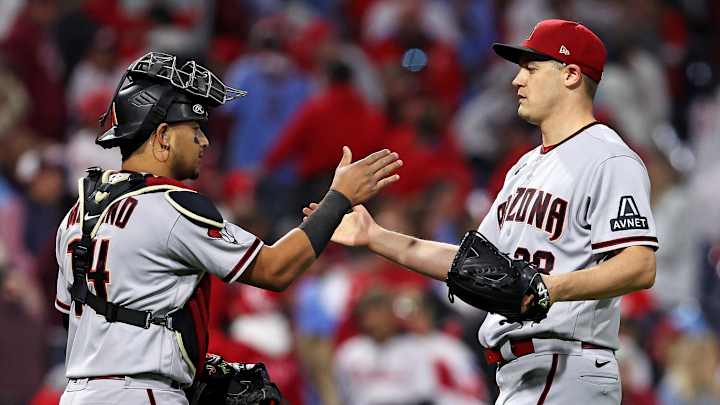Should the D-backs be Concerned About Paul Sewald's Velocity Drop?

In this story:
Paul Sewald is having a good spring training in terms of results. In four outings he has yet to give up a run, allowing just two hits, walked one, and struck out three batters. That included a scoreless 1-2-3 inning at Salt River Fields on Monday.
As previously reported, he is working on a changeup this spring to try and offer a different look and more swing-and-miss options against left-hand batters. If he were able to develop a "plus" changeup, that would certainly make him a much more effective pitcher. Last year his fastball averaged 92.2 MPH last and was even higher than that in the postseason. Due to a different arm angle, it's been a very deceptive, plus pitch for him. His sweeper is also an excellent plus pitch, and he's lived off the combination of the two. Nonetheless, he feels he must develop a plus third pitch to go with the two to maintain effectiveness.
There is one potential problem looming however. His fastball velocity has been down 2.5-3.0 MPH throughout spring training. The pitch has been tracking about 88-91 MPH, with a few right around 90. His Sweeper velocity has been down even more, registering between 3.5-4.0 MPH slower than last year.
According to manager Torey Lovullo, he was told by Sewald that it's normal for him to have a lower velocity in spring. "He said that he doesn't have a lot of velocity in spring training, he kind of works into by the end of spring training so I'm not so concerned about". While we don't have data from last spring, Sewald began the year with an average fastball velocity of just 91 MPH in his first regular season outing of the year. It gradually rose after that before arriving at his season average of 92.2. So alarm bells should not be ringing yet. At the same time, 2.5-3.0 MPH is a lot of ground to make up in a few short weeks. Despite the deception that Sewald relies on, including a flatter angle than most pitchers, it's hard to imagine him being equally effective with a 90 MPH fastball.
It can't be overstated how critical Sewald is to the success of the 2024 season. He was the catalyst for the Diamondbacks bullpen turnaround last year, leading to a postseason run that had the team just three wins away from a world championship. Prior to his arrival from the Mariners in a trade deadline deal, the team did not have an established closer, choosing to go with a bullpen by committee approach. That failed miserably as their 4.44 bullpen ERA through August 1st ranked 23rd in the MLB and 12th in NL. The team was among the worst in baseball in blown saves, and it seemed like the they would squander a promising season.
Then Sewald arrived on August 5th just after the trade deadline to take over the closer's role. He actually blew his first save chance, but then saved seven straight before blowing his second save on August 26th. He went on to record a perfect six for six save rate in September, ending up 13 for 15 in save opportunities over August and September. Moreover, his arrival allowed all the other relievers in the pen to settle into familiar roles and everything clicked for the entire unit. From mid-August onwards, the D-backs bullpen ranked among the best in the NL. With Kevin Ginkel and Ryan Thompson setting up, and newly called up Andrew Saalfrank providing excellent work in September from the left side the team posted a 3.36 reliever ERA from August 15th to the end of the season.
Sewald was even better once the post season got underway. In his first eight games, eight innings, he didn't allow a run and was a perfect six-for-six in save conversions. Simply put, he was nails. Until the World Series. He blew a save in Game 1, giving up a two-run homer to left-hand batter Corey Seager in the 9th. Then in Game 5 he came into the game in the top of the 9th with the D-backs trailing just 1-0. Unfortunately he was banged around for four runs on five hits, including a homer from Marcus Semien. It was a tough ending to a marvelous run. To be clear, the D-backs don't make the postseason without Sewald's great pitching, and he was crucial in helping get the team to the World Series.
There was talk that the Rangers familiarity with Sewald, having seen much of him in the AL West while he was with the Mariners was a factor. He might have even been tipping pitches. So Sewald came into 2024 determined to develop a changeup to help him combat the better lefties in the league and also has worked on avoiding tipping. This is critical for a pitcher that relies on deception. But deception can only do so much in the face of eroding stuff. The team can only hope the velocity does not stay down once the season starts and that he feels confident in the changeup to use it in games that matter.
Sewald Looking to Change Up Arsenal

Jack Sommers is a credentialed beat writer for Arizona Diamondbacks ON SI. He's also the co-host of the Snakes Territory Podcast and Youtube channel. Formerly a baseball operations department analyst for the D-backs, Jack also covered the team for MLB.com, The Associated Press, and SB Nation. Follow Jack on Twitter @shoewizard59
Follow shoewizard59